Gold & Silver Boxes
Gold & Silver Boxes
Browse our collection of Small Antique Silver Boxes including Vinaigrettes, Novelty, Snuff and Tobacco Boxes, Nutmeg Graters
Vinaigrettes, popular from the late 18th century through the end of the 19th century, were small containers used for holding various aromatic substances, usually dissolved in vinegar. A tiny piece of sponge, soaked in the liquid, was contained beneath a grill or perforated cover. Ladies used to carry a vinaigrette with them to combat the aroma from the waste products common in cities. Likewise, the practice of wearing tight corsets also regularly caused a woman to faint, requiring the need to carry smelling salts.
Snuff boxes and Tobacco Boxes.
Tobacco. Tobacco was introduced into Europe circa 1580 however the first tobacco box, with the typical oval form and dome top pull off lid, did not appear until circa 1650. A smoker required a table to set out his “equipment” which included a long stemmed pipe and a pair of ember tongs.
Snuff. It is generally thought that snuff boxes, which were originally designed to be portable, had hinged lids to enable single handed use. The practice of grinding tobacco leaves to inhale the powder was first recorded in 1650 and it’s quick popularity created a demand for snuff boxes. The boxes were made in two sizes; personal boxes to fit in a waistcoat pocket which would hold a small quantity, enough for immediate consumption, and communal boxes made for table use. People of all social classes used these boxes when snuff was at its peak of popularity and the wealthy carried a variety of fancy snuff boxes in precious metals, with jewels, enamels and portrait miniatures. Boxes made for the poorer snuff takers were more ordinary; popular and cheap boxes were made in papier-mâché and even potato-pulp, which made durable boxes that kept the snuff in good condition. Even after snuff-taking ceased to be a general habit, the practice lingered among diplomats, doctors, lawyers and other professionals as well as members of professions where smoking was not possible, such as miners and print workers. Monarchs retained the habit of bestowing snuff-boxes upon ambassadors and other intermediaries as a form of honour.
Nutmeg Graters
Prior to the development of the nutmeg grater box in circa 1670, nutmeg was grated at the table using a steel grater. Early nutmeg graters were either heart shaped or teardrop form, of small size just large enough to contain a nutmeg. The box had two hinged lids, top and bottom, one side with the steel grater, the other containing the grated spice. Other early forms include the tubular variety with pull off lid and silver sleeve, and the rare silver mounted cowrie shell with strapwork mounted grater.
During the 18th century designs progressed to include both functional and very charming novelty and decorative varieties.
The use and manufacture of nutmeg graters was circa 1650-1865 (ref. Eric Delieb “Investing in Silver”) but the earliest fully marked boxes didn’t arrive before circa 1697. The nutmeg originated from the Indies and is mentioned in early literature as a fumigation against the plague.
Counter Boxes.
Not many of these small cylindrical boxes survive from earlier than 1650. They usually have a cap cover, some have pierced sides and even pierced ends. Many of these boxes still contain up to as many as 30 thin silver discs, often finely stamped with the portraits of the Kings and Queens of England. A rare form of these is the circular score box. There is an example in the Birmingham Assay Office by Samuel Pemberton date 1799, the top engraved with the numbers up to 10 and has a moveable pointer. It was probably intended for pool or whist.
-

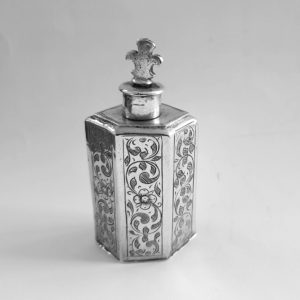
Circa 1580
10187 Elizabeth I Antique Silver Bottle
Sold
A fantastic little collector’s item. A rare 16th century silver bottle, tiny size, probably for perfume oil or holy water. The detachable screw top contains a space inside for either a cork or dip stick. The body is finely engraved with hatched ornament typical of the mid to late 16th century. Weight 20 grams. Height 6.5cm (to the top), 4.3cm (to top of body). Base measures 3.2cm x 2.2cm. English. Circa 1580. Unmarked silver.
-

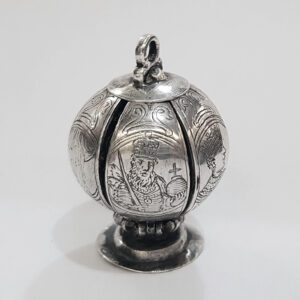
Circa 1600 - 1620
10349 17th Century Antique Silver Pomander
Sold
An intriguing piece of history contained in a small silver sphere. The antique silver pomander was worn round the neck or suspended from a belt and was intended to protect the wearer from sickness. The exterior of this example is hand engraved with royal portraits, probably English, based on engravings by Simon de Passe (c. 1595 – 6 May 1647). The screw top unturns to release six hollow, hinged segments to contain dried flowers, spices and scented oils. The interior is decorated with scroll and hatched engraving. A similar example formed part of the prestigious David Little collection. Weight 22 grams, less than 1 troy ounce. Height 3.9cm. Spread 5.6cm fully extended. Unmarked silver. Probably English. Circa 1600-20.
-

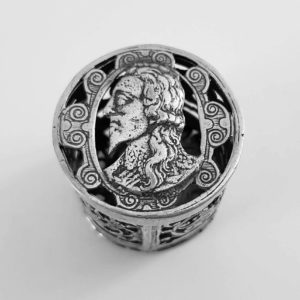
Circa 1635
Simon and Willem De Passe
9993 Charles I Antique Silver Box
Sold
A charming piece of early silver. An antique silver counter box of cylindrical form, the openwork sides pierced with fanciful birds and scrolling foliage. The cover has a bust portrait of Charles I, the base has a bust portrait of Henrietta Maria. This box has no counters.
-

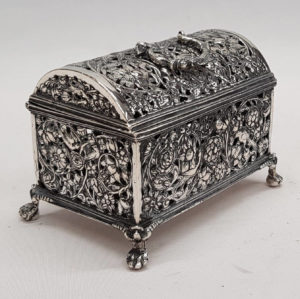
Circa 1660
9471 Antique Dutch Silver Marriage Casket
Sold
A rare 17th century silver wedding box “knottekistje” with a domed and hinged cover and swing handle. The pierced body has scrolling foliage, flowers and birds. Weight 268 grams, 8.6 troy ounces. Height 8.1cm. Length 10.2cm. Depth 6.3cm. Stamped underneath with the flower mark. Circa 1660. Maker unidentified.
-

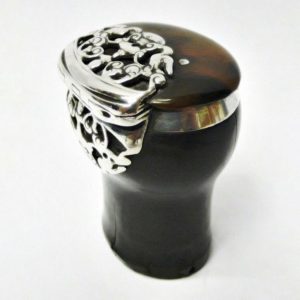
Circa 1671
8260 Antique Silver Snuff Mull
Sold
A charming antique silver mounted horn snuff box having a rising lid with an elaborate silver strapwork hinge and a silver band around the top edge. Attractive waisted shape. Height 6 cms. Top measures 4 x 3.7 cms. Unmarked silver. Most probably Scottish. Underneath there is the incised date “1671” which is probably the original date.
-

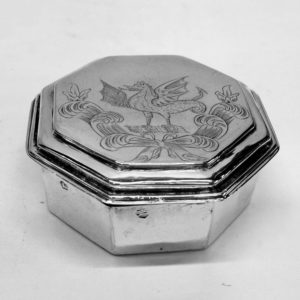
1675
Isaac Dighton
9172 Charles II Antique Silver Boxes
Sold
A very rare matching pair of early antique silver boxes of octagonal form, with pull off tops, dating from the reign of King Charles II. Sterling silver. Simple plain form with a large hand engraved crest within tied plumage, very typical of the date. Superb antique colour. At this date boxes of this type would have originally been part of an extensive toilet service. Total weight 239 grams, 7.6 troy oz. Height 3.5cm. Width of top 9cm. London 1675. Maker Isaac Dighton, London.
-

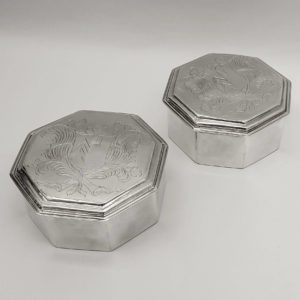
1675
9572 Antique Charles II Silver Boxes
Sold
A very rare matching pair of early antique silver boxes of octagonal form, with pull off tops, dating from the reign of King Charles II. Good size and weight. Sterling silver. Simple plain form with a large hand engraved armorial within tied plumage feathers, very typical of the date. Superb antique colour. At this date boxes of this type would have originally been part of an extensive toilet service. Total weight 645 grams, 20.7 troy ounces. Height 6.3 cm. Width of top 12.7/13.5 cm. London 1675. Maker’s mark “B” – see Jackson’s page 133.
-

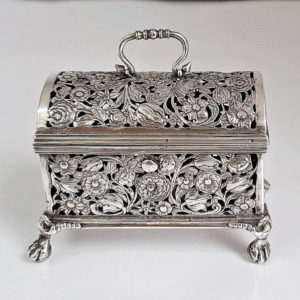
Circa 1680
9724 Antique Dutch Silver Marriage Box
Sold
A 17th century silver casket of traditional rectangular trunk form having a domed top with swing handle. The openwork cast body is smothered in flower heads and scrolling foliage. Bold flowers, including poppies, tulips and daffodils were very popular during the mid to late 17th century. The hand chasing is excellent. The body stands on four little ball and claw feet and has a front locking catch. Weight 159 grams, 5.1 troy ounces. Height 6.6cm (7.5cm with handle extended). Length 8.2cm. Depth 5cm. Stamped inside on the base twice with a maker’s mark (bird?) unidentified. Dutch. Circa 1680.
-

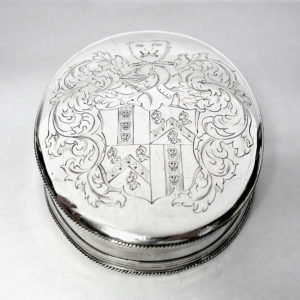
1688
8877 Antique James II Silver Tobacco Box
Sold
A rare early English sterling silver box with lift off top. Simple oval shape and rope borders. This style was popular from the mid 17th century up until the reign of George I. The top has a large hand engraved coat of arms within a decorative cartouche. Weight 120 grams, 3.8 troy ounces. Length 9.2 cms. Width 7.4 cms. Height 2 cms. London 1688. Maker “RH” – see Jacksons page 143*.
-

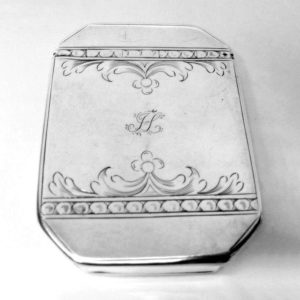
Circa 1690
Elizabeth Haslewood
8255 Antique Norwich Silver Box
Sold
A rare early antique silver snuff box from the provincial city of Norwich. Attractive rectangular octagonal form with hinged lid hand engraved with a scroll design and initials “JL”. Excellent silver patina. Original gilt interior with a deep colour. Weight 63 grams, 2 troy ounces. Height 1,1 cms. Top 7.25 x 5.25 cms. Marked inside the base with initials for the Norwich lady silversmith Elizabeth Haslewood. Makers mark only, circa 1690.
-

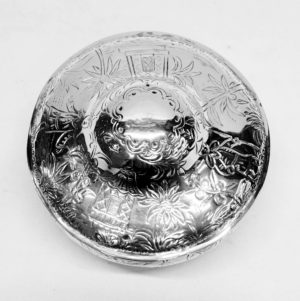
Circa 1690
9150 Antique Silver Chinoiserie Box
Sold
A rare little early antique silver trinket box with a pull off lid and original gilt interior. The engraved decoration is very charming with Chinese figures, pagodas and garden scenes. Weight 141 cm, 4.5 troy ounces. Height 6 cm. Diameter 9.5 cm. Stamped underneath with a crown and 3 stars over the makers initials “LM”. European, possibly English, circa 1690.
-

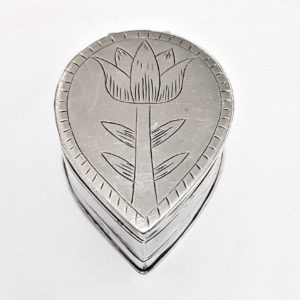
Circa 1690
Mary Elliott
9630 William & Mary Antique Silver Nutmeg Grater
Sold
A William and Mary teardrop shape silver nutmeg grater with steel rasp. With a hinged lid either side. One lid is engraved with a tulip flower, the other has no engraving. Weight 37 grams, 1.1 troy ounce. Height 2 cm. Top 4.2 x 3 cm. Spread across the hinge 4.5 cm. Stamped inside of the lids with makers mark only “ME” conjoined between pellets, bird above, cinquefoil below, in lozenge shaped widow’s shield. Probably Mary Elliott. Circa 1690. Mark references Jackson 1989 p.144.04, David Mitchell “Silversmiths in Elizabethan and Stuart London”
-

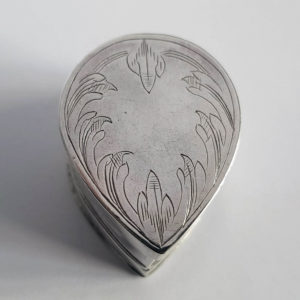
1690
9997 William & Mary Antique Silver Nutmeg Grater
Sold
A charming little late 17th century silver nutmeg grater of teardrop form, one side fitted with a serrated rasp. Each side has a hinged lid with stand-away hinge. Both covers are hand engraved with simple foliate decoration. Weight 29 grams, 0.9 troy ounce. Height 2.5 cm. Top 3.7 x 2.9 cm. Total spread across the covers 8.3cm. Unmarked silver. English. Circa 1690.
-

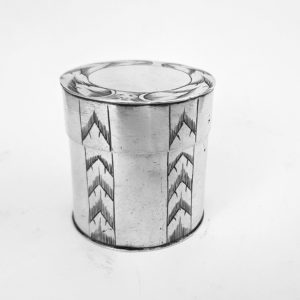
Circa 1690
10151 17th Century Antique Silver Counter Box
Sold
A late 17th century silver counter box of typical cylindrical form with pull-off cover. The lines of hatched engraving resemble that on English silver nutmeg graters circa 1690 and there is a small comical face showing through the border on the lid. Weight 44 grams, 1.4 troy ounces. Height 4.3cm. Diameter 4,.2cm. Unmarked silver. Probably English. Circa 1690.
-

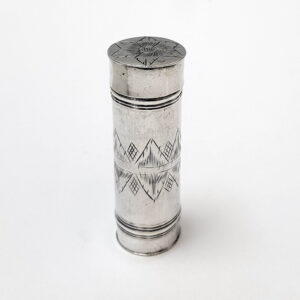
Circa 1690
10333 17th Century Antique Silver Nutmeg Grater
Sold
An attractive little collector’s item. A silver nutmeg grater of cylindrical form, the tube containing a steel grater. The pull off lid is hand engraved with the Tudor rose and the tube has the hatched decoration typical for small silver objects dating back to the final quarter of the 1600’s. Silver weight 14g, about half a troy oz. Length 6.1cm. Diameter 2cm. Maker mark I.I. English circa 1690. Sterling silver.
-

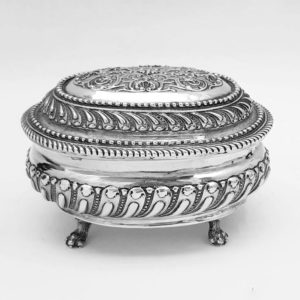
Circa 1700
9593 Antique German Silver Box
Sold
An antique continental silver box with detachable lid and standing on animal’s paw feet. The box has ribbed detail with gadroon and bead borders, the lid with shell and classical motifs. Weight 256 grams, 8.2 troy ounces. Height 9 cm. Top 13.2 x 9.5 cm. Stamped with German silver marks for Augsburg. Circa 1700.
-

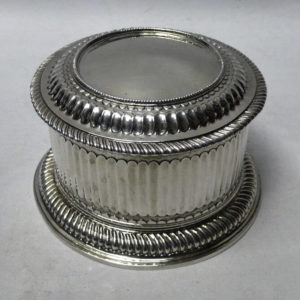
1702
Richard Syng
7929 Antique Queen Anne Silver Boxes
Sold
A very rare matching pair of early antique silver boxes of circular form, with pull off tops, dating from the reign of Queen Anne. Britannia standard silver*. With the typical ribbed decoration of the period and gadroon borders. Uninscribed. Total weight 845 grams, 27.1 troy ounces. Height 10.5 cms. Diameter 12 cms (top), 13.75 cms (base). London 1702. Maker Richard Syng, London.
-

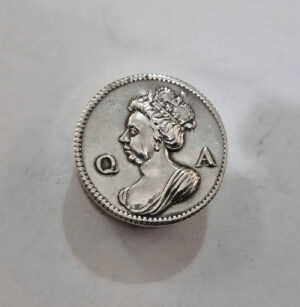
Circa 1710
Thomas Kedder
10454 Queen Anne Antique Silver Box
Sold
A charming little historical item. An early 18th century silver counter box of small size containing 11 embossed gaming counter/medalettes. The pull off cover is embossed with a portrait bust of Queen Anne between “Q and A”. Prick dot owner’s initials “EW” below. Weight 11g. Diameter 2.4cm, 0.95ins. Height 1.1cm, 0.4ins. Maker Thomas Kedder, a known box maker of the period. Circa 1710. Unmarked silver.
-

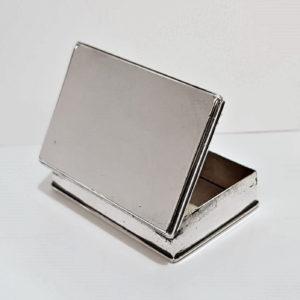
Circa 1714
John Swann
9803 Antique Silver Snuff Box
Sold
A little period gem. A small rectangular silver snuff box with simple plain styling and gilded interior. Queen Anne or George I period. Weight 37 grams, 1.2 troy ounces. Top measures 5cm x 3.5cm. Stamped inside the base with a single makers mark “IS” with the distinctive swan for John Swann. London circa 1714. Britannia standard silver.
-

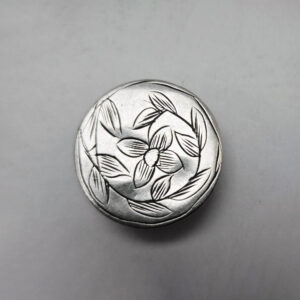
Circa 1720
William Paradise
10455 George II Antique Silver Box
Sold
A sweet little antique silver box with a pull off cover. Tiny size, possibly for pills or counters/tokens. The lid has a hand engraved flower and leaf design in the late 17th century style. Weight 3g. Diameter 1.9cm, 0.75ins. Height 0.9cm, 0.35ins. Maker possibly William Paradise. Circa 1720. Unmarked silver.
-

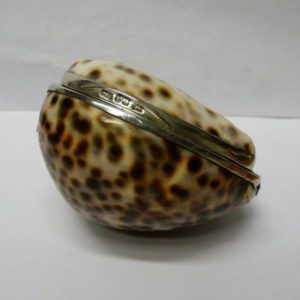
Circa 1740
Dougal Ged
8461 Georgian Silver Cowrie Shell Snuff Box
Sold
A highly collectible antique sterling silver and shell snuff box with a hinged lid. Length 7.5 cms, width 6 cms, height 5 cms. The silver mount bears Scottish hallmarks (badly struck) for Dougal Ged, Edinburgh assay master. Circa 1740.
-

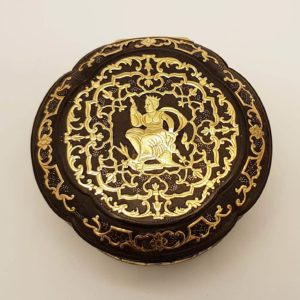
Circa 1740
9621 Antique Gold Pique Box
Sold
An antique tortoiseshell box of circular bombe form inlaid overall with gold pique dot work. The cover and base are overlaid with solid gold cut work ornament of classical figures and motifs. Diameter 6 cm. Height 3.1 cm. Circa 1740. Probably English. Unmarked gold.
-

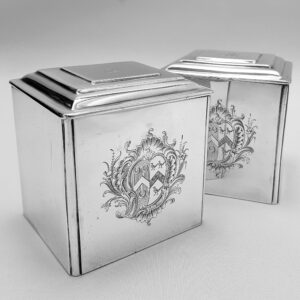
1746
John Swift
10388 George II Pair of Antique Silver Tea Caddies
Sold
An exceptional pair of rectangular silver tea cannisters with stepped hinged lids and canted corners. The plain form, almost cubic, is very attractive. To the front of each is an expansive hand engraved armorial for Martin within a decorative cartouche, the covers have a crest. Total weight 805g, 25.8 troy oz. Height 9.6cm. Width 9.2cm. Depth 8.4cm. London 1746. Maker John Swift. Sterling silver.
-

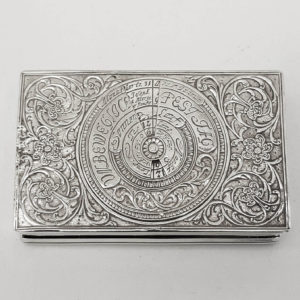
Circa 1750
9674 Antique Silver Perpetual Calendar Snuff Box
Sold
An 18th century silver snuff box with rotating dials to both sides. Very charming and retains the interior gilding. The panels have scrolled flower and chased decoration. The top side has the rotatable “Calendarium Perpetuum” which shows the days of the week (in old German script, and marked with their planetary signs) against days of the month. The reverse side has seven readout windows described by the headings on the rotatable disk (in old German script) – 1) month of the year with its number of days, 2) the important saints’ and feast days in the month, 3) sun’s Zodiacal position (represented by amusing little hand engraved zodiac symbols), 4) length of day, 5) length of night, 6) time of sun rise, and 7) time of sunset. A good example in very good condition. 126 grams, 4 troy ounces. Length 8.4cm. Width 5.5cm. Height 2cm. German. Probably 18th century circa 1750. Unmarked silver.
-

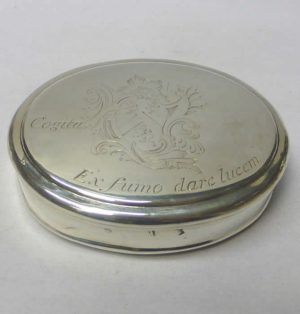
1751
Joseph Smith
7575 George II Tobacco Box
Sold
A charming antique sterling silver box with a detachable lid. Simple oval shape and very plain style. Hand engraved to the top is a contemporary coat of arms and the motto “ex fumo dare lucem” – “to give light from smoke”. This shape was popular from the Restoration through to the early Georgian period. Weight 124 grams, 3.98 troy ounces. Length 11 cms. Width 8 cms. Height 2.5 cms. London 1751. Maker Joseph Smith I.
-

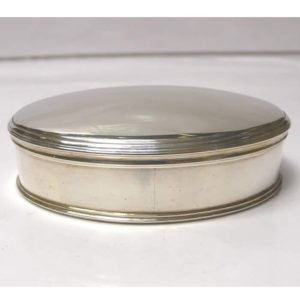
1752
Robert Cox
8418 George II Tobacco Box
Sold
A charming antique sterling silver box with lift off top. Simple oval shape and reeded borders. This style was popular from the mid 17th century up until the reign of George I. Weight 173 grams, 5.5 troy ounces. Length 10.75 cms. Width 8.5 cms. London 1752. Maker probably Robert Cox.
-

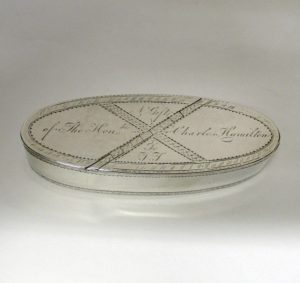
Circa 1760
8463 George III Silver Snuff Box
Sold
A very charming antique sterling silver snuff box of oval shape with an unusual double flap opening mechanism. Hand engraved on the lid with feather edge borders and an inscription in old fashioned script “A Gift of the Hon. Charles Hamilton To TT*. The underside is engraved with bull crest and the motto “I SAVED THE KING”. Retains the original gilt interior. Weight 75 grams, 2.4 troy ounces. Top 9.5 x 3.3 cms. Height 2.1 cms. Unmarked. English, circa 1760.
-

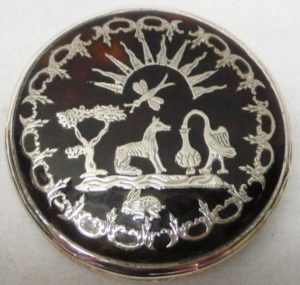
Circa 1760
7869 George III Old Sheffield Plate and Tortoiseshell Snuff Box
Sold
A very early example of Old Sheffield Plate. A rare antique snuff box of circular shape with chased flowers and leaves and a pull off lid. The lid has an inlaid tortoiseshell top with silver pique decoration of the Fox and Crane fable. The base is made from pressed horn. Diameter 5.5 cms. Height 2.3 cms. Circa 1760. No makers mark.
-

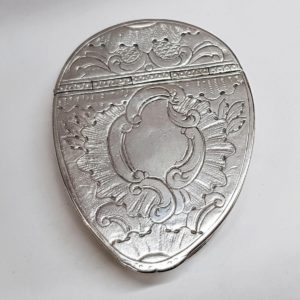
1774
Nathaniel Appleton & Anne Smith
9511 George III Silver Snuff Box
Sold
An antique sterling silver snuff box with hinged lid. The top is engraved with scroll and sea foam motifs with a large central cartouche (uninscribed). The interior retains the original gilding. Weight 40 grams, 1.2 troy ounces. Top measures 6 x 4.7 cm. Height 1.2 cm. London 1774. Maker Nathaniel Appleton & Smith.
-

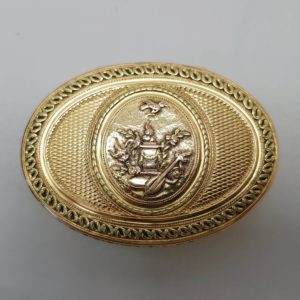
1775
Elori-Denis Thierry
10206 Louis XVI Antique French Gold Box
Sold
A superb French vari-colour gold snuff box of oval form charmingly presented with decorative applied plaques. The lid has a central love trophy of hearts, love birds, flaming torches and a mandolin; the four side plaques have gardening and musical themes. Weight 86 grams, just under 3 troy ounces. Length 6.7cm. Width 4.8cm. Height 2.5cm. Paris 1775. Maker Elori-Denis Thierry. High grade gold, 3 colours, 18 carat.
-

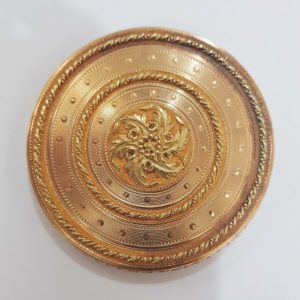
1784
Nicolas Choconain-Delaunay
10270 Louis XVI Antique French Gold Box
Sold
A superb French vari colour gold snuff box (or bonbonniere) of circular form with detachable pull off cover. Large size and heavy gauge. The cover, sides and base have concentric panels, stamped at intervals with pellets, within bands of line engraving and rope twist. The execution is excellent especially the detailed matted background. Weight 127 grams, 4 troy ounces. Diameter 7.2cm. Height 2.2cm. Paris 1784/85. Maker Nicolas-Jean-Baptiste Choconain-Delaunay. Vari colour gold. 18 carat (75% purity). 18th century.
-

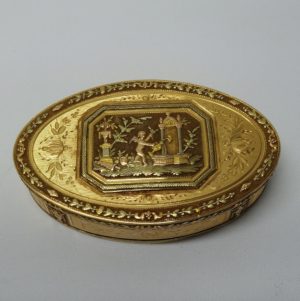
1790 - 1805
8958 Antique Gold Box
Sold
An outstanding Swiss five-colour gold snuff box of oval form, the cover applied with an octagonal gold panel. The decorative classical scene shows Cupid in a garden filling water at a fountain. Weight 64 grams, just over 2 troy ounces. Top 8×5 cms. Height 2 cms. Makers mark stamped inside cover and side, VR under crown, this maker worked in Paris and Geneva, 1790-1805. Belgian import marks stamped to the side. High grade gold, probably 18 carat.